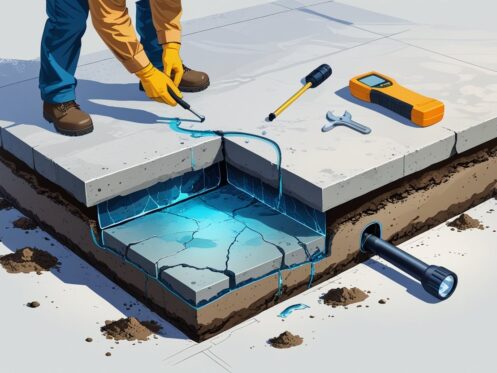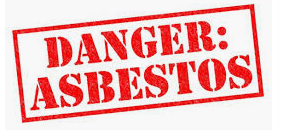If you suspect your slab is leaking, it’s important to recognize the telltale signs early to avoid costly damage to your home’s foundation. Common indicators include unexplained increases in your water bill, damp or warm spots on your floors, and cracks in your walls or foundation. These hints suggest water is escaping from pipes beneath the concrete slab, posing a serious risk if left unchecked.
You might also notice sounds of running water when no taps are open or find pools of water around your home’s base. Detecting a slab leak requires a mix of observation and testing, such as turning off all water sources and monitoring your water meter for movement. Splash Plumbing in Anaheim, CA, has the experience needed to accurately diagnose these issues to protect your property from further harm.
Knowing how to identify a slab leak early can save you time and money while preventing structural damage. Read on to learn the key warning signs and effective steps you can take to address this problem before it worsens. Whether you need advice or expert repair, Splash Plumbing is ready to help.
What Is a Slab Leak?
A slab leak happens when a water line beneath your concrete foundation breaks or corrodes, causing water to escape. These leaks can lead to structural issues, higher water bills, and water damage if not detected soon. Knowing how slab leaks happen and where they occur helps you identify problems early.
Understanding Concrete Slab Foundations
Your home’s plumbing is often embedded in a thick concrete slab foundation. This slab is a flat, solid layer of concrete that supports the entire structure and houses vital water lines beneath its surface. Because these plumbing pipes are hidden under the slab, any leak remains out of sight until damage becomes visible.
Concrete slab foundations are common in warmer climates where freezing isn’t a big concern. Water pipes run through or under the slab to supply your house, but the concrete makes it difficult to access these pipes for inspection or repair. This setup puts your plumbing at risk for undetected leaks beneath your floor.
Types of Plumbing Leaks Under the Slab
Slab leaks typically involve broken or corroded water lines beneath the concrete foundation. Common types include:
- Pinhole leaks: Small holes caused by corrosion or wear that slowly drip water.
- Cracks or splits: Larger breaks in pipes from shifting soil or pressure.
- Joint leaks: Failures where pipe connections weaken or break.
Any of these leaks release water inside or below the slab, potentially causing mold, puddles, or foundation damage. Because the leak is often underground, you might notice related signs like high water bills or low water pressure before spotting the leak itself.
How Slab Leaks Occur
Slab leaks happen when water lines beneath your concrete slab become damaged. Causes include:
- Corrosion due to metal pipe deterioration over time.
- Shifting soil or ground movement putting stress on pipes.
- Poor installation leading to weak joints or wrong pipe placement.
- High water pressure causing pipes to crack or burst.
Leaks can go unnoticed for months or longer because the pipes are hidden. Early detection is critical to avoid foundation damage. If you suspect a slab leak, contacting a trusted professional like Splash Plumbing can ensure prompt diagnosis and repair. Proper tools, including electronic leak detection and video inspections, help locate leaks without unnecessary slab demolition. For more detailed detection and repair info, visit this slab leak repair guide.
Key Warning Signs Your Slab Is Leaking
Slab leaks can cause hidden damage beneath your home’s foundation. Detecting them early is crucial to avoid costly repairs and maintain your water system’s efficiency. Several specific signs point to a leak under your slab that needs immediate attention.
Unexplained High Water Bills
A sudden, unexplained increase in your water bill is one of the clearest indicators of a slab leak. Even a small pinhole leak under the slab can waste thousands of gallons of water monthly. Check your water bill history regularly; a sharp spike without increased usage suggests water is escaping somewhere underground.
If your bill rises consistently with no changes in household habits, this might indicate a hidden leak in your hot water line or plumbing beneath the concrete slab. It’s important to address this quickly to avoid escalating water damage and higher costs. A specialist from Splash Plumbing can help locate and repair these leaks efficiently.
Low or Changing Water Pressure
If your water pressure drops suddenly or fluctuates without an apparent cause like municipal issues, you should suspect a slab leak. Broken or cracked pipes beneath the slab reduce water flow and can affect pressure in multiple fixtures.
You might notice weak flow in taps or showers or experience inconsistent pressure when different faucets are used simultaneously. This variability often signals a break or leak where water escapes underground. Low water pressure combined with other signs such as high water bills strengthens the case for a slab leak.
Unusual Dampness or Warm Spots on Floors
Damp or warm spots on your floors are an important physical warning sign. Water leaking beneath the slab can saturate the ground and cause moisture to rise through the concrete. This often results in soggy patches, discoloration, or even bubbling paint on the floor.
Warm spots specifically point to leaks in hot water lines under your slab. The escaping hot water warms the flooring, which can be felt by touch. If you detect a persistent mildew smell in these areas, it’s a further indication that moisture is accumulating and fostering mold growth. This condition requires prompt inspection to prevent structural damage.
Sounds of Running Water When Not in Use
Hearing the sound of running or dripping water when all faucets and appliances are off can indicate a slab leak. The noise comes from water escaping pressurized pipes underground.
Listen carefully near walls or floors where the slab lies. Persistent sounds of water flow or dripping are not normal and should prompt a leak investigation. Early detection based on these auditory cues can save significant repair costs and water waste.
If you suspect a slab leak from any of these signs, professional help from a company like Splash Plumbing in Anaheim, CA, can provide accurate leak detection and effective repair solutions.
Physical and Structural Indicators
When a slab leak occurs, you may notice specific changes in your home’s physical structure and surroundings. These signs often point directly to problems beneath your foundation, signaling the need for immediate attention.
Damaged or Warped Flooring
Uneven or warped flooring is a primary indication that water is escaping beneath your slab foundation. You might see certain floor sections feeling soft, spongy, or even sagging.
Wood floors tend to buckle or cup when exposed to moisture, while tiles can loosen or crack. Vinyl and laminates may bubble or peel. These changes happen because water from a leak undermines the materials’ stability.
If you experience sudden changes in your flooring texture or appearance, it’s important to investigate further. Ignoring warped floors can worsen water damage and lead to structural issues.
Cracks in Walls or Foundation
Cracks appearing in your walls or foundation can hint at ongoing slab leaks. Water escaping beneath your slab compromises the soil’s integrity, causing shifts and settling of the foundation.
Look for vertical or horizontal cracks, especially near corners, door frames, or windows. Wider gaps or cracks growing over time are more concerning. These fissures can allow moisture and pests into your home.
Such cracks not only reduce your home’s structural integrity but also signify potential water damage beneath the surface. Seek professional evaluation promptly to avoid costly repairs.
Mold and Mildew Growth
Unexplained mold or mildew growth inside your home often accompanies slab leaks. Moisture trapped beneath or around your foundation creates an environment where mold spores thrive.
You might notice visible mold patches on walls, floors, or near baseboards. Additionally, a damp or musty odor could persist in certain areas. Long-term moisture encourages mold growth that affects indoor air quality and health.
Addressing a slab leak quickly minimizes water damage and limits mold spread. If you see or smell mold without obvious cause, contact a plumbing expert like Splash Plumbing for inspection.
Water Pooling Indoors or Outdoors
Pooling water, whether inside your home’s perimeter or around the foundation outside, is a clear warning of slab leaks. This water can emerge through cracks or seepage points in the concrete slab or nearby soil.
Indoors, watch for unexplained puddles in basements, crawlspaces, or near walls. Outside, saturated soil or water pooling after light rain may indicate compromised drainage linked to leaks.
Standing water can accelerate structural damage, encourage erosion, and foster mold growth. Persistent water issues require prompt diagnosis and repair to protect your property.
For residents near Anaheim or throughout Orange County, Splash Plumbing offers thorough slab leak detection and repair services to help safeguard your home.
Common Causes of Slab Leaks
Slab leaks happen when water pipes beneath your concrete foundation develop cracks or holes. This can lead to water damage inside your home and costly repairs if not addressed quickly. The main causes of slab leaks usually involve pipe damage, construction faults, or ground movement.
Pipe Corrosion and Material Deterioration
Over time, water pipes beneath your slab foundation can deteriorate due to corrosion. This is common with older copper pipes, which may weaken from mineral buildup or chemical reactions in the soil. When pipes corrode, tiny holes or cracks develop, leading to leaks beneath the concrete slab.
Materials like polybutylene or galvanized steel are also prone to degradation or failure. Once corrosion starts, leaks often worsen quickly, causing moisture to pool under your home. Early signs include unexplained water bills, hot spots on floors, or damp areas near walls. Repairing corroded pipes requires professional detection and replacement to prevent further damage.
Improper Installation or Poor Construction
Faulty plumbing installation is a frequent cause of slab leaks. Pipes placed without proper bedding, support, or protection under the concrete are vulnerable to damage. Poor construction may result in pipes rubbing against rough surfaces or concrete that causes premature wear.
Incorrect pipe materials or inadequate sealing during installation can also lead to leaks. For instance, if flexible pipes are bent sharply or joints are not sealed tightly, leaks can form early in a home’s life. If your home is newer but showing leak signs, consider that poor construction could be to blame and seek a thorough plumbing inspection.
Shifting Soil and Foundation Movement
The soil beneath your slab foundation often shifts due to moisture changes, droughts, or settling. This movement can put stress on the pipes running underneath your concrete slab. When the soil shifts unevenly, it can cause pipes to bend, crack, or disconnect.
Expansive clay soils are particularly risky because they swell with water and shrink when dry, creating pressure on plumbing systems. If your area experiences frequent drought or heavy rains, soil movement becomes a significant threat to your pipes. Protecting your slab requires monitoring both soil conditions and any signs of foundation movement, such as cracks in walls or floors.
For expert help with slab leaks and to keep your foundation safe, contact a trusted local plumber like Splash Plumbing. They offer reliable detection and repair services for Anaheim and surrounding areas. More on causes and prevention can be found at Splash Plumbing’s detailed resources about slab leaks.
How to Confirm a Slab Leak
Confirming a slab leak involves a combination of simple checks you can do yourself and more advanced methods used by professionals. Being thorough with these steps helps you identify the leak’s presence and severity, which is essential before starting repairs or calling for expert help.
DIY Leak Checks and Meter Tests
Start by turning off all water appliances and fixtures in your home. Then, check the water meter for movement. If the meter is still running, it indicates water is flowing somewhere, possibly due to a leak beneath your slab.
Another quick test is to monitor your water bill. A sudden, unexplained spike often signals a slab leak. You can also inspect your floors for warm spots or the appearance of damp areas, both common signs of leaks under concrete.
Use this basic test regularly as an early detection method before significant damage occurs. This method might not pinpoint the exact leak location, but it gives you a strong indication to look deeper.
Professional Leak Detection Techniques
A professional plumber uses specialized tools like electronic amplifiers, infrared cameras, and pressure testing to locate a slab leak precisely. These techniques measure sound waves or temperature differences to detect moisture under your foundation with high accuracy.
Pressure testing involves temporarily isolating parts of your plumbing and monitoring pressure changes to find leaks. Video sewer line inspections might also be employed to check for pipe damage.
Plumbing services like Splash Plumbing provide expert slab leak detection that reduces guesswork, prevents unnecessary damage, and ensures the problem is accurately identified before repairs begin.
When to Contact a Professional Plumber
If your DIY checks suggest a leak or you notice structural issues like cracked floors or unusually high water bills, contact a professional immediately. Slab leaks can worsen quickly, damaging your foundation and increasing repair costs.
Early professional intervention ensures safe and effective slab leak detection and repair, protecting the integrity of your home. Licensed plumbers will also handle complex pressure testing, slab leak detection, and necessary plumbing services, giving you peace of mind.
For residents near Anaheim, CA, Splash Plumbing offers trusted expertise in slab leak detection and repair with nearly 30 years of experience serving Orange County.
Slab Leak Repair and Prevention
Dealing with a slab leak requires both precise repairs and preventive measures to protect your home’s foundation and plumbing system. Repairs vary from targeted fixes to more extensive pipe replacements, while prevention focuses on reducing future damage risks through proper maintenance and early detection.
Spot Repair and Direct Access Solutions
Spot repair targets the exact location of a slab leak without disturbing large sections of your foundation. This method usually involves creating a small access point to reach and fix the damaged pipe directly.
Spot repairs minimize disruption and cost, but they depend on accurately locating the leak. Technologies like electronic leak detection and infrared cameras help pinpoint leaks beneath the slab.
Direct access may require concrete cutting, but modest repairs reduce overall foundation disturbance. For slab leaks near frequently used plumbing, spot repair can be a quick and effective solution. Splash Plumbing uses these techniques to provide efficient slab leak repair with minimal impact.
Repiping and Pipe Rerouting Options
If slab leaks are extensive or recurring, repiping or pipe rerouting may be necessary. Repiping involves replacing old or damaged pipes under your concrete slab entirely.
This method is more invasive but offers a long-term solution by installing durable materials such as PEX or PVC that resist corrosion and leaks. Rerouting places new pipes above the slab or in accessible areas to avoid future foundation issues.
While repiping and rerouting involve higher upfront costs, they often prevent repeated plumbing slab leak problems and foundation repair expenses. Splash Plumbing can guide you on whether repiping is right based on your home’s condition and leak history.
Minimizing Future Risks of Slab Leaks
Preventing slab leaks involves regular plumbing inspections and maintaining water pressure within safe limits. Look for early signs such as unusual sounds, increased water bills, or damp spots inside your home.
Ensuring your home’s foundation stays dry avoids cracks that can worsen leaks. Installing water alarms and pressure regulators helps detect leaks quickly and reduces pipe stress.
Proper landscaping and avoiding heavy irrigation near your foundation are critical as excess moisture can accelerate concrete damage. Working with experienced plumbers like Splash Plumbing can provide you with tailored advice and early repair options to safeguard your plumbing slab leak risks.
Frequently Asked Questions
Slab leaks often begin quietly but present clear signs and risks. Understanding common symptoms, detection methods, causes, and costs helps you act promptly to avoid extensive damage. Insurance coverage varies and should be reviewed carefully.
What are the common signs of a slab leak?
You may notice sudden spikes in your water bill without increased usage. Warm spots on your flooring, damp or moldy areas, the sound of running water when all faucets are off, and low water pressure are all key indicators.
How does one accurately detect a slab leak in a home?
Detection typically requires professional equipment like electronic amplifiers, thermal imaging cameras, or acoustic listening devices. A licensed plumber, such as those at Splash Plumbing, can perform thorough diagnostics to pinpoint leaks beneath the concrete slab.
Can a slab leak cause major damage if left unaddressed?
Yes. Over time, a slab leak can compromise your home’s foundation, cause structural damage, promote mold growth, and damage flooring and walls. Early detection is crucial to prevent costly repairs.
What factors typically lead to the development of a slab leak?
Common causes include corrosion of copper pipes, shifting or settling of the foundation, high water pressure, poor construction, and natural wear over time. Pipes penetrating the concrete are vulnerable spots.
What is the average cost of repairing a leak in a concrete slab?
Repair costs vary depending on the leak’s size and location. On average, repairs range from $1,000 to $4,000, but extensive damage or complex access can increase expenses. The process may involve breaking concrete, pipe replacement, or pipe lining.
To what extent does homeowners insurance cover slab leak repairs?
Coverage depends on your policy. Some policies exclude slab leaks or only cover damage caused by the leak rather than the leak repair itself. It’s important to review your specific policy or consult your insurance provider.












